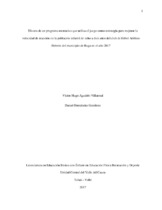Efectos de un programa recreativo que utiliza el juego como estrategia para mejorar la velocidad de reacción en la población infantil de 8 a 10 años del Club de Fútbol Atlético Hebrón del municipio de Buga en el año 2017

Ver / Descargar
Fecha
2017-07-06Autor
Agudelo Villarreal, Víctor Hugo
Hernández Gutiérrez, Daniel
Resumen
The speed of reaction in the practice of soccer, is one of the qualities that differentiate players who give quick answers to different stimuli, it is possible to
develop at ages between eight and
ten years. Accordingly, the research work aimed to improve the Reaction Rate in the infantile population of the Hebrón Athletic Soccer Club in the city of Buga,
for which the Litwin and Fernández VR Test (1984) was chosen. Because it allowed the evaluation of the physical capacity of the player, evaluated the time
of elective reaction, had simple requirements, practical application, execution and measurement, required little space and carried out activities close to
game situations. It also had a 98% confidence level, so that using a random table proposed by the authors, 20 children aged 8 to 10 years were evaluated. In
the first part, the pre-test was applied to determine the state of this variable in the participants. In the second part of the study, according to the findings, the
intervention plan was executed based on a recreational program, to later use the post-test, thus verifying the hypothesis derived from a methodological design of
quantitative type, longitudinal cut and explanatory scope. The results validated the positive effect of recreation to improve the Reaction Rate in children training
Soccer, as it was observed that the variable had a normal distribution both in the pre-test and in the post-test, in addition to the Statistically significant difference,
since the student T test yielded a significance of <0.05 whereby the alternative hypothesis of investigation was accepted and the null hypothesis was
accepted La Velocidad de Reacción en la práctica del fútbol, es una de las cualidades que diferencian a los
jugadores que dan rápidas respuestas ante los diferentes estímulos, ésta se logra desarrollar en las
edades de entre ocho y diez años. Acorde con esto, el trabajo de investigación tuvo como
objetivo mejorar la Velocidad de Reacción en la población infantil del Club de Fútbol Atlético Hebrón de la ciudad de Buga, para lo cual se
utilizó el Test de VR de Litwin y Fernández (1984), escogido porque permitía la valoración de la capacidad física del jugador, evaluaba el tiempo de
reacción electivo, tenía requerimientos sencillos, de práctica aplicación, ejecución y medición, requería de poco espacio y llevaba a cabo actividades
cercanas a situaciones de juego. También presentaba un nivel de fiabilidad del 98%, de ahí que, utilizando una tabla aleatoria planteada por los autores,
se evaluaron 20 niños de ocho a diez años de edad. En la primera parte, se aplicó el pre-test logrando determinar el estado de esta variable en los
participantes. En la segunda parte del estudio, se ejecutó el plan de intervención basado en un programa recreativo, para posteriormente hacer uso
del post-test, logrando así comprobar la hipótesis derivada de un diseño
metodológico de tipo cuantitativo, corte longitudinal y alcance explicativo. Los resultados obtenidos validaron el efecto positivo que tiene la
recreación para mejorar la Velocidad de Reacción en los niños que entrenan fútbol, pues se observó que la variable tuvo una distribución normal
tanto en el pre-test como en el post-test, además de la diferencia estadísticamente significativa, ya que la prueba T de student arrojo una
significancia de <0.05 por lo cual se aceptó la hipótesis alterna de investigación y se rechazó la nula.
Descripción
ilustraciones, gráficos, tablas

